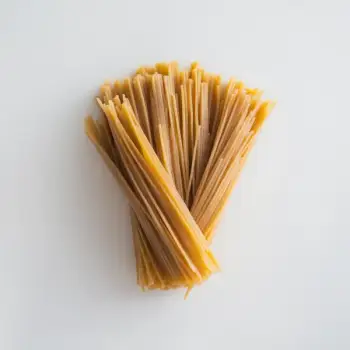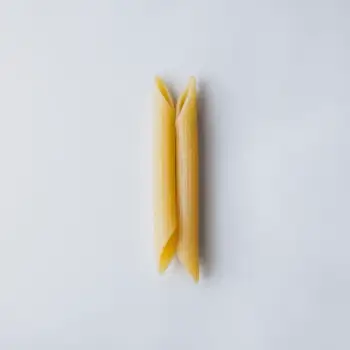Rigatoni and Penne are both tube-shaped Italian pastas with ridges, ideal for different sauces—rigatoni for hearty, thick sauces due to its larger size, and penne for lighter, creamier sauces.

Rigatoni is a popular pasta shape in Italian cuisine. It is larger than penne and characterized by its ridged surface and wide, tube-like structure which is excellent for holding sauces.

Penne is a classic pasta type that's tube-shaped with angled cuts. Its surface can be smooth (penne lisce) or ridged (penne rigate), and it's well-suited for a variety of sauces, particularly lighter ones which cling to the pasta's ridges.
Rigatoni and penne differ in size, shape, and texture. Rigatoni is typically larger with a wider diameter and more pronounced ridges, making it better for thicker, chunkier sauces. Penne, being smaller and with a smoother surface, pairs well with lighter, cream-based or oily sauces.

Your ultimate Recipe Box, Meal Planner, and Cooking Class all in one
Rigatoni's large size and ridges make it an excellent choice for baked ziti or pasta al forno, where it holds onto cheese and sauce between layers. Penne's smaller size can work well in lighter baked dishes like pasta casseroles with vegetables and chicken. For meaty sauces such as Bolognese, rigatoni's wide openings allow for hearty bites of meat and veggies to be captured within the pasta. Penne can be used for smoother meat sauces, where the meat is finer or ground. Rigatoni pairs well with rustic, chunky vegetable sauces, allowing the veggies and pieces of tomato to nestle inside. Penne, on the other hand, can be a better match for more homogenized vegetable sauces, like a creamy spinach and walnut pesto. Penne is often preferred for seafood dishes with delicate sauces, such as shrimp with a light tomato cream sauce. Rigatoni may be too large and overpowering for such ingredients but can be used in seafood pasta with chunkier tomato or vegetable-based sauces.
Both rigatoni and penne are made from similar ingredients, typically semolina flour, so their nutritional content is quite similar. The choice between them should be based on sauce pairing and personal preference.
| Nutrient | Penne ( per 100 grams ) | Rigatoni ( per 100 grams ) |
|---|---|---|
| Fat | 1.2g | 1.5g |
| Fiber | 3g | 3g |
| Sodium | 2mg | 6mg |
| Protein | 12g | 12g |
| Calories | 352 | 358 |
| Carbohydrates | 71g | 73g |
Yes, you can use penne instead of rigatoni in a baked pasta dish, but the texture and sauce capture will be different due to the size difference.
Rigatoni is typically better for chunky tomato-based sauces due to its larger size and ridges. Penne works well with smoother tomato-based sauces.
Penne is usually preferred for creamy sauces as its smaller size and ridges complement the lightness of the sauce.
Both pastas can be used in pasta salads, but rigatoni may hold onto more of the dressing due to its larger size and ridges.
Light, delicate sauces that might be overshadowed by rigatoni's large size and ridges are best avoided.